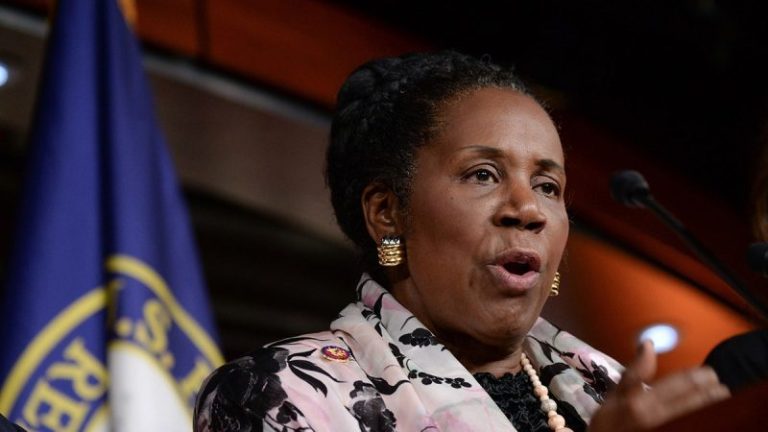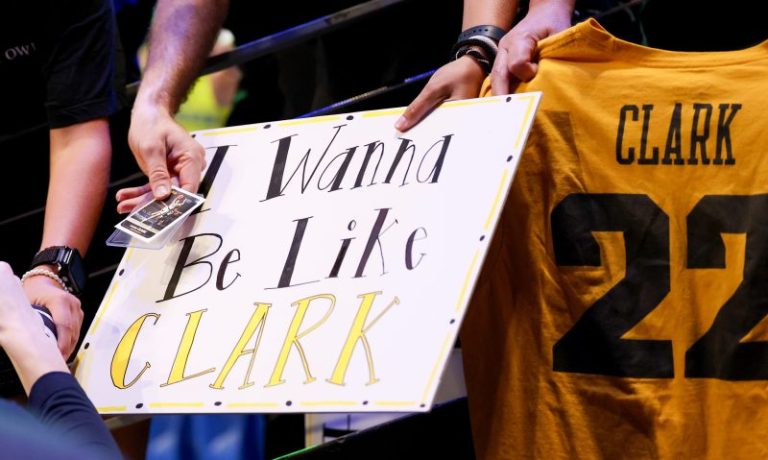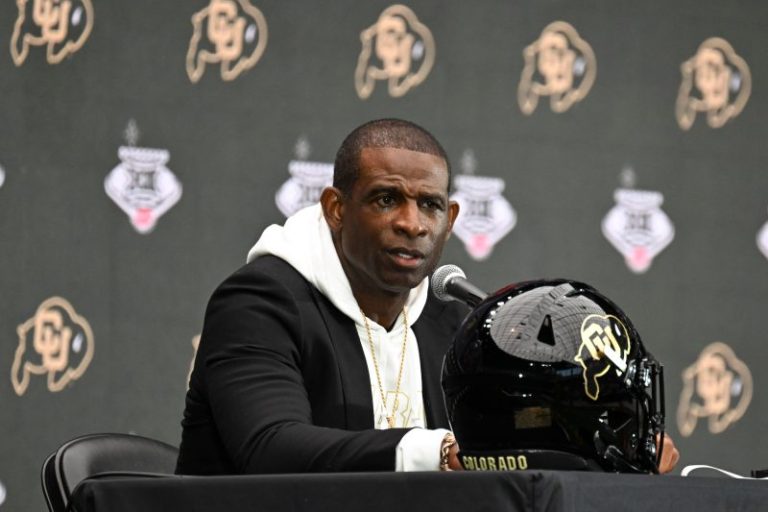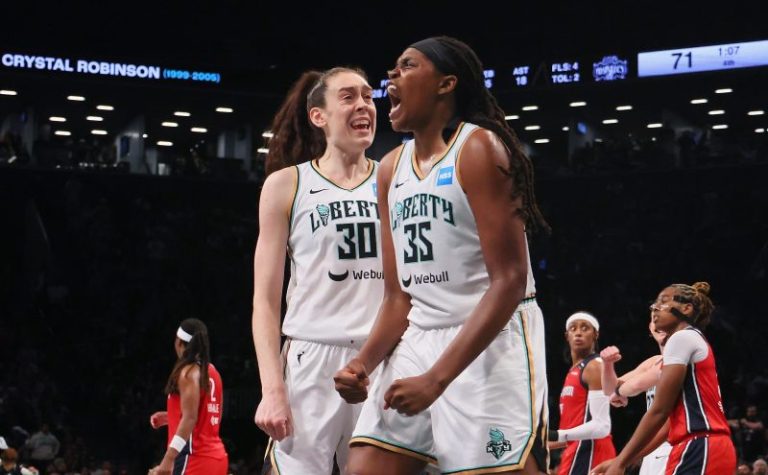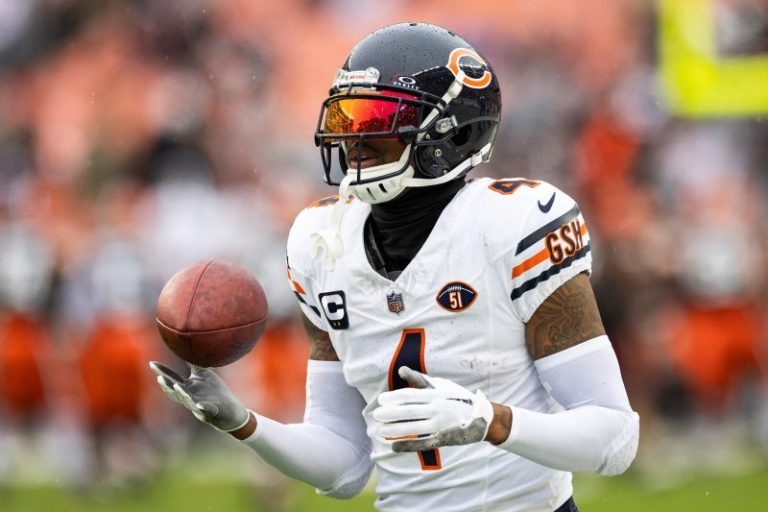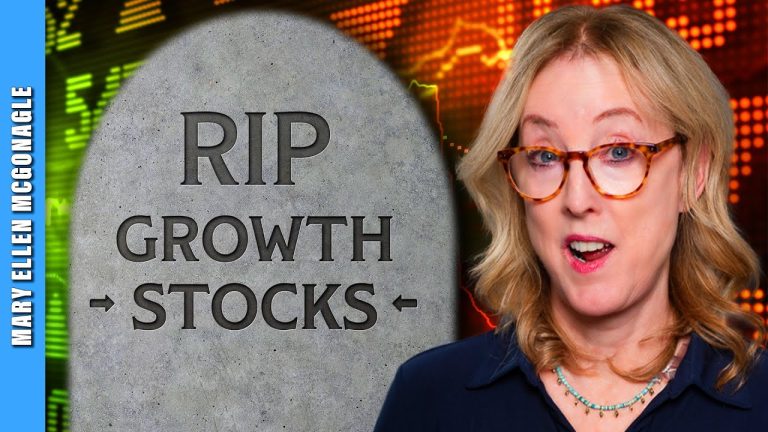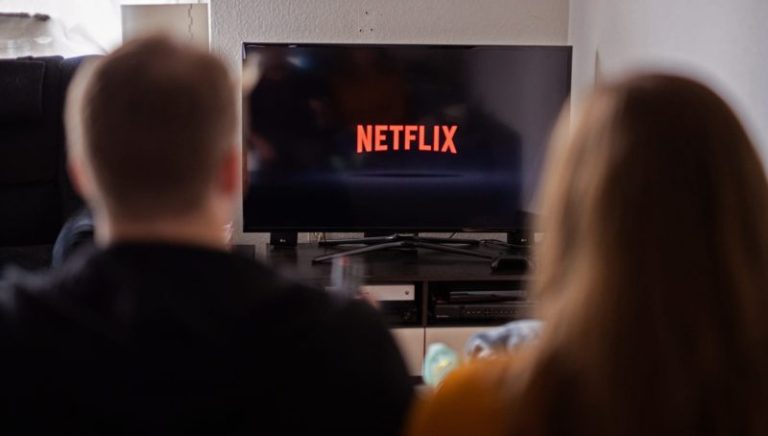Shane Lowry will take a two-shot lead into the third round of the 2024 British Open at Royal Troon Golf Club
Lowry is at 7-under overall after shooting 2-under on Friday, pulling ahead of opening round leader Daniel Brown – who is now tied for second with Justin Rose at 5-under for the tournament.
Some of the biggest names in the game missed Friday’s cut, including Bryson DeChambeau (9-over), Rory McIlroy (11-over) and Tiger Woods (14-over).
“I’m going to have a very late tee Saturday tomorrow. I’m not going to be playing for another 24 hours,” Lowry told reporters after his morning round Friday. “I know what that’s about. I know tomorrow is going to be a long day, but I’ve done it before.”
Lowry won the Open in 2019, when it was played in Northern Ireland.
Here’s how the second round unfolded on Friday:
British Open leaderboard
(overall scores through Friday)
1. Shane Lowry, -7T2. Daniel Brown, -5T2. Justin Rose, -5T4. Billy Horschel, -2T4. Dean Burmester, -2T4. Scottie Scheffler, -2T7. Four golfers tied at -1
British Open cut: Rory McIlroy among big names eliminated
After Rory McIlroy’s U.S. Open heartbreak in June, he had one more chance to grab a major and went 78-75. He was 6-over through six holes on Friday, making an 8 on the fourth hole that sealed his fate.
“That was it, 22 holes into the event and I’m thinking about where I’m going to go on vacation next week,” he said.
McIlroy has now gone 10 years and 40 majors without a major championship victory and he’ll have to wait until April and the Masters for his next chance.
“When I look back on the two majors that I didn’t play my best at, here and the Masters, the wind got the better of me on Friday at Augusta, and then the wind got the better of me the last two days here,” he said.
– Adam Schupak, Golfweek
Rory McIlroy holes out from bunker
Rory McIlroy is heading toward elimination as his second round wraps up, but managed to hole out from a bunker to birdie No. 14 on Friday, birdying on No. 16 as well
Daniel Brown atop British Open leaderboard
‘Not used to being in this position … but it’s been good,’ British Open leader Daniel Brown said after his round Friday. ‘It’s been a challenge to manage my expectations from [Thursday]. … I was pretty sure that today wasn’t going to go quite as smoothly as yesterday. I’m happy that I managed to grind it out and post a reasonable number.
‘There’s still a long way to go, so I’m not going to get ahead of myself.’
Justin Rose finishes round tied for second
England’s Justin Rose made a long birdie putt on 18 to wrap his second round and put him at 5-under overall, tied for second with Daniel Brown, two shots behind leader Shane Lowry.
Bryson DeChambeau chips in birdie
Bryson DeChambeau is battling for his life Friday after a miserable 5-over opening round and chipped in for birdie to cap off his front nine in the second round.
Justin Rose pulls closer to the lead
Justin Rose picked up his third birdie of the day on the 16th to move him to 4-under for the tournament. He’s one stroke behind second-place Daniel Brown and three behind leader Shane Lowry. He has just one bogey.
Jon Rahm chips in long shot for birdie
Jon Rahm gets a birdie on the ninth with this shot.
Rory McIlroy struggling in second round
He shot an 8 on the par 5 fourth hole and bogeyed on the third, fifth and sixth holes. He was +13 through six holes.
Brown in second after round
Daniel Brown ends his second round with a par, good for 1-over par. he heads to the weekend two shots behind leader Shane Lowry.
McIlroy starts second round, attempting to make cut, Rose continues streak
Rory McIlroy began his day with an uphill climb to make the projected cut line of 5-over. Starting at 7-over, he left his birdie putt a few feet short on the first hole. On the par 4 second hole, his driver landed him in the rough, landing 117 yards from the hole, with his second landing in the semi-rough and left a 7-foot putt to save par, which he nailed.
Justin Rose is playing mistake-free golf after saving par on the 9th hole and has now gone 27 holes without a bogey. He currently sits at 4-under.
Justin Rose makes his move, Scottie Scheffler within striking range
Justin Rose is off to an outstanding start in his second round. After a beautiful approach on the 7th, Rose easily made birdie to move within three shots of the lead. Scottie Scheffler, seeking his third major championship, bogeyed the 18th but is still five shots off the pace heading into the weekend.
Shane Lowry finishes second round with two-shot lead
Shane Lowry capped off an impressive second round with a birdie putt on the par four 18th and finished his 18 holes at 2-under, 69. He sits at 7-under, a two-shot lead over Daniel Brown, and hit the clubhouse as the winds started picking up for the rest of the field trying to catch up.
Tiger Woods misses the cut, finishes 14-over par
Tiger Woods had two days he would like to forget at the Open Championship at Royal Troon Golf Course in Troon, Scotland. After carding an 8-over 79 during the first round, it was more of the same on Friday for the 15-time major winner as he missed the cut at his third straight major tournament, finishing at 14-over par. The last time that happened was in 2015, when he failed to make the weekend at the U.S. Open, The British Open, and the PGA Championship.
Shane Lowry retakes sole possession of the lead
Shane Lowry birdies the 16th hole to take the outright lead once again. Daniel Brown sits one stroke behind. Meanwhile, Justin Rose sits three strokes off the lead after a birdie on the par-5 4th. Rose is the only golfer on the course who as not bogeyed a hole through 22 holes.
British Open leaderboard
As of 9:02 a.m. ET
T1. Shane Lowry, -5T1. Daniel Brown, -53. Justin Rose, -3T4. Dean Burmester, -2T4. Russell Henley, -2T4. Billy Horschel, -2T4. Nicolai Hojgaard, -2T8. Eight golfers tied at -1
Daniel Brown lands birdie, back as co-leader
Daniel Brown started his back nine in style by making a birdie putt on the 450-yard par-4 No. 10. That puts Brown back into a tie for the lead with Shane Lowry at 5 under. Lowry has been even through the second round through 15 holes.
Wind kicking up at Royal Troon
It wouldn’t be a British Open without the elements coming into play. And, almost suddenly, wind is impacting play all around Royal Troon. It’s going to make the second half of this second round pretty interesting.
Bogey on No. 2 for Justin Thomas
Justin Thomas started the second round in a tie for third place at 3 under, but the two-time PGA Championship winner has already given one back.
After saving par on No. 1, Thomas bogeyed the 389-yard par-4 hole on No. 2. Thomas remains in a tie for third at 2 under.
Daniel Brown hits the turn after another bogey
Daniel Brown has fallen out of the lead after carding his second bogey of the second round on No. 9.
That makes Shane Lowry, at 5 under through 13 holes, the solo leader at the moment.
Chaos on No. 11 for Shane Lowry
Shane Lowry runs into some trouble on No. 11. He hits his second shot into a gorse bush, cursing at a cameraman. Lowry then drops and hits a provisional onto the green to 20 feet in what would have presumably led to a bogey. However, a spectator found his second shot in the middle of the gorse bush. More than 20 minutes later, Lowry takes a drop and hits it to the front of the green. He then two putts for a costly double bogey and moves back into a share for the lead with Daniel Brown.
Patrick Cantlay moving up the leaderboard
Patrick Cantlay is perhaps having the best round of the day. The American birdies No. 10 to take him 4 under on the round and 2 under for the championship. He moves within five strokes of the leader Shane Lowry.
Shane Lowry takes outright lead
Shane Lowry birdies No. 8 − the Postage Stamp hole − to take the outright lead of The Open. The Irishman is 3 under par for the day to lead by one over Daniel Brown.
Shane Lowry shares lead with Daniel Brown
Shane Lowry, the 2019 Open champion, picks up two early birdies on No. 1 and No. 4 to take the outright lead of The Open and becomes the first player to reach 7 under in this championship. However, that was met by a bogey on No. 5 to move into a tie with Daniel Brown for the lead. Brown is even through the first two holes.
Tiger Woods stumbles out the gate to start second round
Tiger Woods, who recorded six bogeys and two double bogeys in an opening 79, got off to a rough start to begin the second round. Woods double bogeyed the second hole and bogeyed the fifth hole to sit a +11 and tied for 151st. He then recorded his first birdie on No. 6 but is in danger of missing the cut.
How to watch 2024 British Open on TV
The Open will be broadcast live on NBC and on USA Network, with coverage also on NBC’s Peacock streaming service. The tentative broadcast schedule is as follows (all times Eastern):
Round 2: Friday, July 19
1:30 a.m.- 4 a.m.: Peacock 4 a.m.-3 p.m.: USA Network 3 p.m.-4 p.m.: Peacock
British Open 2024 live stream
Live coverage and featured groups can be followed on the live stream on Peacock.
British Open tee times: Second round
All times Eastern
1:35 a.m. — Ewen Ferguson, Marcel Siem
1:46 a.m. — CT Pan, Romain Langasque, Yuto Katsuragawa
1:57 a.m. — Rikuya Hoshino, Angel Hidalgo, Richard Mansell
2:08 a.m. — Corey Conners, Ryan Fox, Jorge Campillo
2:19 a.m. — Ernie Els, Gary Woodland, Altin van der Merwe (a)
2:30 a.m. — Henrik Stenson, Rasmus Hojgaard, Jacob Skov Olesen (a)
2:41 a.m. — Louis Oosthuizen, Billy Horschel, Victor Perez
2:52 a.m. — Sepp Straka, Brendon Todd, Jordan Smith
3:03 a.m. — Denny McCarthy, Taylor Moore, Adrian Meronk
3:14 a.m. — Jason Day, Byeong Hun An, Rickie Fowler
3:25 a.m. — Alex Cejka, Eric Cole, Kurt Kitayama
3:36 a.m. — Darren Clarke, JT Poston, Dean Burmester
3:47 a.m. — Phil Mickelson, Joost Luiten, Dustin Johnson
4:03 a.m. — Padraig Harrington, Davis Thompson, Matthew Jordan
4:14 a.m. — Wyndham Clark, Hideki Matsuyama, Brooks Koepka
4:25 a.m. — Tiger Woods, Xander Schauffele, Patrick Cantlay
4:36 a.m. — Collin Morikawa, Sam Burns, Si Woo Kim
4:47 a.m. — Shane Lowry, Cameron Smith, Matt Fitzpatrick
4:58 a.m. — Jordan Spieth, Scottie Scheffler, Cameron Young
5:09 a.m. — Akshay Bhatia, Tom Hoge, Sami Valimaki
5:20 a.m. — Emiliano Grillo, Ben Griffin, Mackenzie Hughes
5:31 a.m. — Yannik Paul, Joe Dean, Andy Ogletree
5:42 a.m. — Ryan van Velzen, Charlie Lindh, Luis Masaveu (a)
5:53 a.m. — Kazuma Kobori, Jaime Montojo Fernandez (a), Liam Nolan (a)
6:04 a.m. — Daniel Brown, Denwit David Boriboonsub, Matthew Dodd-Berry (a)
6:15 a.m. — Jeunghun Wang, Aguri Iwasaki, Sam Horsfield
6:26 a.m. — Justin Leonard, Todd Hamilton, Jack McDonald
6:47 a.m. — Tom McKibbin, Alex Noren, Calum Scott (a)
6:58 a.m. — Jesper Svensson, Vincent Norrman, Michael Hendry
7:09 a.m. — Younghan Song, Daniel Hillier, Ryosuke Kinoshita
7:20 a.m. — Min Woo Lee, Ryo Hisatsune, Abraham Ancer
7:31 a.m. — Nicolai Hojgaard, Adam Scott, Keita Nakajima
7:42 a.m. — Francesco Molinari, Justin Rose, Jasper Stubbs (a)
7:53 a.m. — Justin Thomas, Sungjae Im, Matthew Southgate
8:04 a.m. — Nick Taylor, Matt Wallace, Laurie Canter
8:15 a.m. — Sebastian Soderberg, Matteo Manassero, Shubhankar Sharma
8:26 a.m. — Zach Johnson, Austin Eckroat, Thorbjorn Olesen
8:37 a.m. — John Daly, Santiago de la Fuente (a), Aaron Rai
8:48 a.m. — Stewart Cink, Chris Kirk, Dominic Clemons (a)
9:04 a.m. — Stephan Jaeger, Adam Schenk, Joaquin Niemann
9:15 a.m. — Adam Hadwin, Lucas Glover, Christiaan Bezuidenhout
9:26 a.m. — Tony Finau, Russell Henley, Matthieu Pavon
9:37 a.m. — Jon Rahm, Tommy Fleetwood, Robert MacIntyre
9:48 a.m. — Ludvig Åberg, Bryson DeChambeau, Tom Kim
9:59 a.m. — Brian Harman, Viktor Hovland, Sahith Theegala
10:10 a.m. — Rory McIlroy, Max Homa, Tyrrell Hatton
10:21 a.m. — Keegan Bradley, Will Zalatoris, Gordon Sargent (a)
10:32 a.m. — Harris English, Maverick McNealy, Alexander Bjork
10:43 a.m. — Guido Migliozzi, Sean Crocker, Tommy Morrison (a)
10:54 a.m. — David Puig, John Catlin, Guntaek Koh
11:05 a.m. — Thriston Lawrence, Daniel Bradbury, Elvis Smylie
11:16 a.m. — Nacho Elvira, Minkyu Kim, Darren Fichardt
11:27 a.m. – Mason Andersen, Masahiro Kawamura, Sam Hutsby
This post appeared first on USA TODAY

